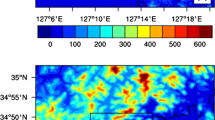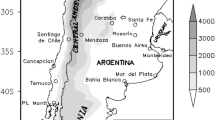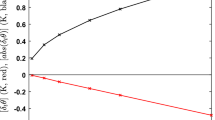Abstract
A low-level nocturnal wind maximum is shown to exist over extensive and nearly undisturbed rainforest near the central Amazon city of Manaus. Analysis of meteorological data collected during the 1985 and 1987 Amazon Boundary Layer Experiments (ABLE 2A and 2B) indicates the presence of this nocturnal wind maximum during both the wet and dry seasons of the Central Amazon Basin. Daytime wind speeds which are characteristically 3–7 m s-1 between 300 and 1000 m increase to 10–15m s-1 shortly after sunset. The wind speed maximum is reached in the early evening, with wind speeds remaining high until several hours after sunrise. The nocturnal wind maximum is closely linked to a strong low-level inversion formed by radiational cooling of the rainforest canopy. The night-time inversion extends up to 300 m with strong vertical shear of the horizontal wind below the inversion top and uniformly strong horizontal winds above the inversion top. Frictional decoupling of the air above the inversion from the rough forest below, however, is responsible for only part of the observed increase. Surface and low-level pressure gradients between the undisturbed forest and the large Amazon river system and the city of Manaus are shown to be responsible for much of the nocturnal wind increase. The pressure gradients are interpreted as a function of the thermal differences between undisturbed forest and the river/city. The importance of both the frictional decoupling and the horizontal pressure gradient suggest that the nocturnal wind maximum does not occur uniformly over all Amazonia. We suspect that stronger low-level winds are pervasive under clear skies and strong surface cooling and that, in many places (i.e., near rivers), local pressure gradients enhance the low-level nocturnal winds.
Similar content being viewed by others
References
Blackadar, A. K.: 1957, ‘Boundary-Layer Wind Maxima and their Significance for the Growth of Nocturnal Inversions’, Bull. Amer. Meteorol. Soc. 38 283–290.
Bonner, W. D.: 1968, ‘Climatology of the Low Level Jet’, Mon. Wea. Rev. 96 83–95.
Brook, R. R.: 1985, ‘The Koorin Nocturnal Low Level Jet’, Boundary-Layer Meteorol. 32 133–154.
Clarke, R. H. and Brook, R. R.: 1979, The Koorin Experiment, Australian Government Publishing Service, Bureau of Meteorology, Canberra, Australia, 359 pp.
Clarke, R. H., Dyer, A. J., Brook, R. R., Reid, D. G., and Troup, A. J.: 1971, The Wangara Experiment: Boundary-Layer Data, Tech. Paper No. 19, Division of Meteorological Physics, CSIRO, Australia.
DeSouza, R. L., Aspliden, C. I., Garstang, M., LaSeur, N. E., and Hsueh, Y.: 1971, ‘A Low-Level Jet in the Tropics’, Mon. Wea. Rev. 99 559–563.
Dickerson, R. B. and Neumann, H. H.: 1982, ‘The Occurrence of Nocturnal Low-Level Jets in New England and the Canadian Maritimes’, Atmos.-Ocean 20 287–300.
Garratt, J. R.: 1982, ‘Observations in the Nocturnal Boundary Layer’, Boundary-Layer Meteorol. 22 21–48.
Garratt, J. R.: 1985, ‘The Inland Boundary Layer at Low Latitudes’, Boundary-Layer Meteorol. 32 307–327.
Garstang, M., Ulanski, S., Greco, S., Scala, J., Swap, R., Fitzjarald, D., Martin, D., Browell, E., Shipman, M., Connors, V., Harriss, R., and Talbot, R.: 1990, ‘The Amazon Boundary Layer Experiment (ABLE 2B): A Meteorological Perspective’, Bull. Amer. Meteorol. Soc. 71 19–31.
Greco, S., Garstang, M., Ulanski, S., Houston, S., and Swap, R.: 1989, ‘Local Circulations over the Central Amazon Basin’, Proc. Third International Conf. on Southern Hemisphere Meteorology and Oceanography, pp. 213–215.
Greco, S., Swap, R., Garstang, M., Ulanski, S., Shipham, M., Harriss, R. C., Talbot, R., Andreae, M., and Artaxo, P.: 1990, ‘Rainfall and Surface Kinematic Conditions over Central Amazonia during ABLE 2B’, J. Geophys. Res. 95 17001–17014.
Harriss, R., Wofsy, S., Garstang, M., Browell, E., Molion, L., McNeal, R., Hoell, J., Bendura, R., Beck, S., Navarro, R., Riley, J., and Snell, R.: 1988, ‘The Amazon Boundary Layer Experiment (ABLE 2A): Dry Season’, J. Geophys. Res. 93 1351–1360.
Harriss, R., Garstang, M., Wofsy, S., Beck, S., Bendura, R., Coelho, J., Drewry, J., Hoell, J., Matson, P., McNeal, R., Molion, L., Navarro, R., Rabine, V., and Snell, R.: 1990, ‘The Amazon Boundary Layer Experiment: Wet Season 1987’, J. Geophys. Res. 95 16721–16736.
Hoecker, W. H.: 1963, ‘Three Southerly Low-Level Jet Systems Delineated by the Weather Bureau Special Pibal Network’, Mon. Wea. Rev. 91 573–582.
Hoecker, W. H.: 1965, ‘Comparative Physical Behavior of Southerly Boundary-Layer Wind Jets’, Mon. Wea. Rev. 93 133–144.
Hsu, S. A.: 1979, ‘Mesoscale Nocturnal Jet-Like Winds within the Planetary Boundary Layer over a Flat, Open Coast’, Boundary-Layer Meteorol. 17 485–494.
Kousky, V. E.: 1979, ‘Frontal Influence on Northeast Brazil’, Mon. Wea. Rev. 107 1140–1153.
Kousky, V. E. and Ferreira, N. J.: 1981, ‘Interdiurnal Surface Pressure Variation in Brazil: Their Spatial Distributions, Origins and Effects’, Mon. Wea. Rev. 109 1999–2008.
Kousky, V. E. and Kagano, M.: 1981, ‘A Climatological Study of the Tropospheric Circulation over the Amazon Region’, Acta Amazonica 11 743–758.
Kraus, H., Malcher, J., and Schaller, E.: 1985, ‘A Nocturnal Low-Level Wind during PUKK’, Boundary-Layer Meteorol. 31 187–195.
Lettau, H. H.: 1967, ‘Small to Large-Scale Features of Boundary Layer Structure over Mountain Slopes’, Proc. Symp. Mount. Meteor., Atmos. Sci. Paper No. 122, Colorado State University.
Lettau, H. H.: 1983, ‘Thoughts on Priorities in Boundary-Layer Research’, Boundary-Layer Meteorol. 25 429–432.
Mahrt, L.: 1981, ‘The Early Evening Boundary Layer Transition’, Quart. J. Roy. Meteorol. Soc. 107 329–343.
McNider, R. and Pielke, R.: 1981, ‘Diurnal Boundary-Layer Development over Sloping Terrain’, J. Atmos. Sci. 38 2198–2210.
Nobre, C. A., Suva Dias, P., dos Santos, M. A. R., Cohen, J., da Rocha, J. P., Guedes, R., Ferreira, R., and dos Santos, J. A.: 1987, ‘Mean Large Scale Meteorological Aspects of ABLE 2B’, Paper presented at Spring AGU Meeting, Baltimore, MD.
Oliveira, A. P.: 1990, Planetary Boundary Layer Dynamics over the Amazon Rain Forest, Ph.D. dissertation, College of Sciences and Mathematics, Department of Atmospheric Sciences, State University of New York at Albany, 295 pp.
Paegle, J.: 1987, ‘Interactions between Convective and Large-Scale Motions over Amazonia’, in R. Dickerson (ed.), The Geophysiology of Amazonia: Vegetation and Climate Interactions, Wiley Intersciences, New York, pp. 347–390.
Paegle, J. and Rasch, G. E.: 1973, ‘Three-Dimensional Characteristics of Diurnally Varying Boundary-Layer Flows’, Mon. Wea. Rev. 101 746–755.
Salati, E. and Vose, P. B.: 1984, ‘Amazon Basin: A System in Equilibrium’, Science 225 129–138.
Shuttleworth, W. J., Gash, J., Lloyd, J., Moore, C. J., Robert, C. J., Filho, A., Fisch, G., Filho, V., Ribeiro, M., Molion, L., Sa de Abreu, L., Nobre, C., Cabral, O. M. R., Pitel, S. R., and Moraes, J. C.: 1984, ‘Observation of Radiation Exchange above and below Amazonian Forest’, Quart. J. Roy. Meteorol. Soc. 110 1163–1169.
Shuttle worth, W. J., Gash, J., Lloyd, J., Moore, C. J., Robert, C. J., Filho, A., Fisch, G., Filho, V., Ribeiro, M., Molion, L., Sa de Abreu, L., Nobre, C., Cabral, O. M. R., Pitel, S. R., and Moraes, J. C.: 1985, ‘Daily Variations of Temperature and Humidity within and above Amazonian Forest’, Weather 40 102–108.
Silva Dias, P., Benatti, J. P., and Kousky, V.: 1987, ‘Diurnally Forced Tropical Tropospheric Circulation over South America’, Mon. Wea. Rev. 115 1465–1478.
Thorpe, A. J. and Guymer, T. H.: 1977, ‘The Nocturnal Jet’, Quart. J. Roy. Meteorol. Soc. 103 633–653.
Virji, H.: 1981, ‘A Preliminary Study of Summertime Tropospheric Circulation Patterns over South America Estimated from Cloud Winds’, Mon. Wea. Rev. 109 599–610.
Wexler, H.: 1961, ‘A Boundary Layer Interpretation of the Low-Level Jet’, Tellus 13 368–378.
Wippermann, F.: 1973, ‘Numerical Study on the Effects Controlling the Low-Level Jet’, Beitr. Phys. Atmos. 46 137–154.
Zeman, O.: 1979, ‘Parameterization of the Dynamics of Stable Boundary Layer and Nocturnal Jets’, J. Atmos. Sci. 36 792–804.
Author information
Authors and Affiliations
Rights and permissions
About this article
Cite this article
Greco, S., Ulanski, S., Garstang, M. et al. Low-level nocturnal wind maximum over the central Amazon basin. Boundary-Layer Meteorol 58, 91–115 (1992). https://doi.org/10.1007/BF00120753
Accepted:
Issue Date:
DOI: https://doi.org/10.1007/BF00120753




